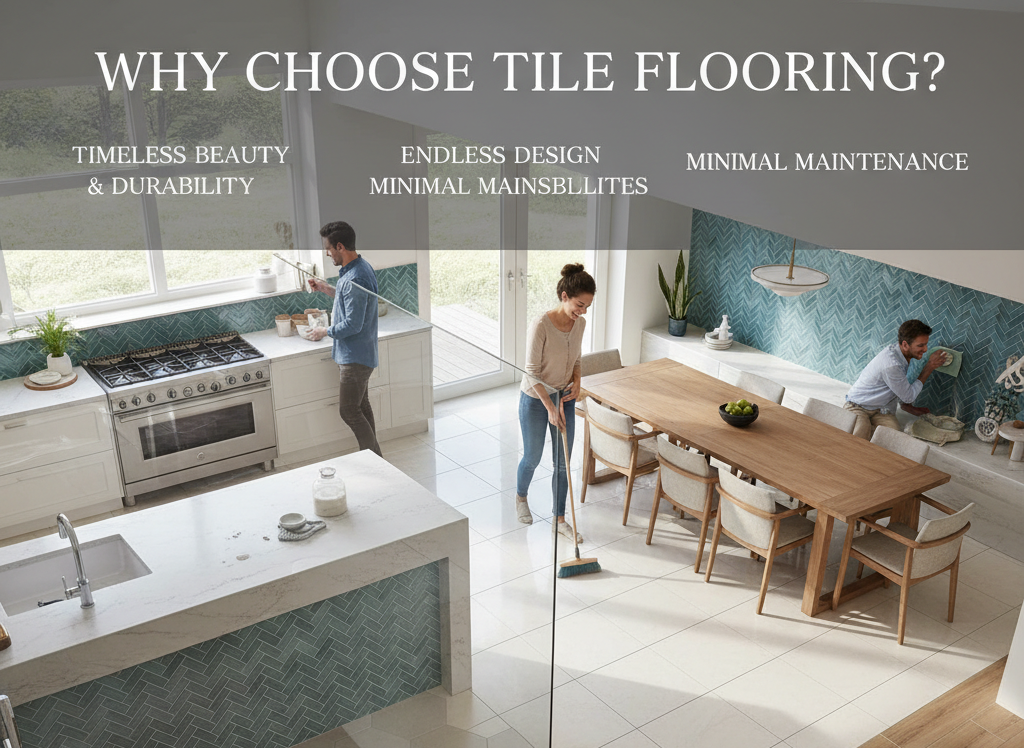Tile flooring, whether porcelain or ceramic, brings timeless beauty and long-lasting performance to your home. From a slip-resistant bathroom floor that ensures safety during bath time to a stylish kitchen backsplash that grabs attention, tiles offer endless design possibilities. They combine elegance with durability and require minimal maintenance — perfect for modern, busy households.
Types of Tile Floors
When choosing tiles, you can select between ceramic and porcelain, both crafted from clay and known for their strength and water resistance. Each type offers unique advantages to suit your home’s style and functional needs.
1. Ceramic Tile
Ceramic tiles are a classic choice, available in numerous colours, patterns, and finishes. They are affordable, easy to clean, and suitable for almost any room in the house.
2. Porcelain Tile
Porcelain tiles are denser and more durable than ceramic. They resist stains and moisture, making them ideal for high-traffic and wet areas such as kitchens, bathrooms, and laundry rooms.
3. Natural Stone Tile
Natural stone tiles like marble, granite, and travertine add luxury and elegance to any space. Though more expensive, they are highly durable and have a rich, timeless appearance.
4. Glass Tile
Glass tiles offer a distinctive, eye-catching look. Available in multiple colours and shapes, they’re perfect for creating modern, sleek designs or traditional patterns for walls and backsplashes.
Factors to Consider When Choosing Tile Flooring
- Traffic Level: Opt for strong tiles in high-traffic areas like hallways or living rooms.
- Moisture Exposure: For damp spaces like bathrooms or kitchens, choose tiles that resist water and stains.
- Design & Style: Pick tiles that enhance your home’s overall décor and colour palette.
- Budget: Set a budget in advance since tile costs vary by material, quality, and size.
With proper care and installation, tile flooring can last for decades, adding both beauty and value to your home.
Tile Flooring Appearance and Design Options
Today’s tiles combine practicality with stunning looks. From wood-look porcelain tiles that bring warmth to living rooms, to marble-look floor tiles for elegant bathrooms — you can design every room just the way you like.
At Durga Marble, we stock tiles in every finish — glossy, matte, rustic, or textured — and in all popular sizes, from 300×300 mm to 1200×2400 mm slabs.
Pros and Cons of Tile Flooring
✅ Advantages
- Budget-friendly and long-lasting
- Easy to clean and maintain
- Available in diverse colours, sizes, and styles
- Resistant to water and scratches
❌ Disadvantages
- Grout lines may require regular cleaning
- Tiles can feel cold underfoot
- Installation can be time-consuming
- Heavy tiles need a strong subfloor for support
Porcelain vs Ceramic Floor Tile
Both porcelain and ceramic tiles are excellent choices, but they differ mainly in their composition and durability.
Porcelain tiles are made from a refined clay mixture and fired at higher temperatures, making them denser and more water-resistant — ideal for bathrooms, kitchens, and laundry areas.
Ceramic tiles, on the other hand, are slightly more porous and best suited for indoor, low-moisture spaces.
Wall Tiles
If you’re designing a spa-like bathroom or an elegant kitchen backsplash, porcelain wall tiles are perfect for high-moisture zones. Their lightweight design and wide variety of finishes make them a great choice for accent walls and decorative applications.
Durability of Tile Flooring
Despite their sleek appearance, ceramic and porcelain tiles are incredibly strong. They can withstand daily wear and tear from children, pets, and heavy foot traffic without losing their charm. With proper care, your tile flooring can easily last 20–30 years or more.
Tile Flooring Cost
Tile flooring costs depend on:
- Tile material and quality (ceramic, porcelain, stone, or glass)
- Size of the space and quantity required
- Installation complexity and labour charges
Generally, smaller spaces like kitchens cost less to tile than large open floors. Premium tiles and intricate patterns may increase the overall expense but offer a lasting return on investment.
Tile Flooring Lifespan and Installation
With proper installation and maintenance, tiles can last for decades.
Key factors influencing longevity include:
- Professional installation and proper sealing
- High-quality materials and grout
- Regular cleaning and maintenance
- Following manufacturer’s care guidelines
Poor installation or uneven grout can shorten your floor’s lifespan. Always hire a qualified tile installer to ensure durability and protect your warranty.
Maintaining Tile Floors
Keeping your tile floor clean is simple:
- Sweep or vacuum regularly to remove dust and dirt.
- Mop occasionally using mild detergent and warm water.
- Follow the manufacturer’s cleaning instructions.
- Seal grout annually to prevent moisture damage.
With minimal effort, your tiles will maintain their shine and strength for years.
Tips for Choosing and Installing Tile Flooring
- Hire a professional installer for best results.
- Plan your design layout before purchase.
- Choose tiles that suit your room function and style.
- Maintain and seal tiles regularly to extend their life.
Tile Flooring FAQs
What is the best tile for a bathroom floor?
Both ceramic and porcelain tiles work well, but porcelain is slightly better for wet areas due to its low water absorption.
What is the best tile for a shower floor?
Porcelain tiles are ideal for showers as they resist moisture and are less slippery.
Is tile better than vinyl?
Both have benefits, but tile offers a more durable, elegant, and heat-resistant option — especially in kitchens and bathrooms.
Can floor tiles be used on walls?
Yes, but wall tiles should not be used on floors since they are thinner and not built to bear heavy weight.
What kind of tile is best for flooring?
Porcelain or ceramic tiles are best for most homes. Choose based on water exposure, traffic level, and design preference.
What is the best tile for a kitchen floor?
Both porcelain and ceramic tiles perform well in kitchens — they handle spills, stains, and heavy use with ease.

